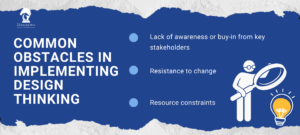Content
SHARE

In today’s highly competitive business landscape, finding ways to differentiate your brand from the rest is crucial. One approach that has gained traction in recent years is design thinking. By putting the needs and desires of the consumer at the forefront, design thinking allows brands to create meaningful experiences that resonate with their target audience. In this article, we will explore the concept of design thinking and discuss practical steps to incorporate it into your brand strategy, with a specific focus on empathy.

Understanding the Concept of Design Thinking
At its core, design thinking is a problem-solving approach that prioritises user-centricity. It involves understanding the target audience’s needs, wants, and pain points. By adopting a design thinking mindset, brands can uncover unique insights that lead to innovative solutions. In essence, design thinking is all about tapping into the user mindset to create experiences that matter.
The Core Principles of Design Thinking
Several key principles underpin design thinking:
- Empathy: The ability to understand and share the feelings of another plays a central role in design thinking. By empathising with the user, brands can gain invaluable insights into their needs and emotions, ultimately leading to more meaningful solutions.
- Collaboration: Design thinking is a team effort. It encourages cross-functional collaboration, bringing together individuals with different backgrounds and expertise to foster the exchange of ideas and diverse perspectives.
- Iteration: Design thinking is an iterative process. It involves constant experimentation, refinement, and learning from failures. By embracing a mindset of continual improvement, brands can evolve their solutions to meet the target audience’s needs.
The Role of Empathy in Design Thinking
Empathy lies at the heart of design thinking. By putting yourself in the user’s shoes, you can deeply understand their desires, motivations, and pain points. This understanding allows you to design experiences that truly resonate with your audience, fostering a strong emotional connection between your brand and consumers.
In empathy in design thinking, it’s important to go beyond surface-level understanding. It’s about delving into the user’s world, immersing yourself in their experiences, and truly feeling what they feel. This level of empathy enables you to uncover insights that might otherwise go unnoticed, leading to breakthrough solutions that address the user’s unmet needs.
Furthermore, empathy in design thinking is not limited to just understanding the user’s emotions. It also involves understanding their context, their environment, and the challenges they face. By considering the broader context in which the user operates, you can design user-centric solutions and consider the wider ecosystem in which they exist.
The Importance of Empathy in Brand Strategy
Empathy is a powerful tool for brands that want to create lasting impressions. When consumers feel understood and valued, they are more likely to develop a strong affinity towards a brand. By incorporating empathy into your brand strategy, you can foster a sense of trust and loyalty that will keep customers coming back for more.
Understanding the consumer’s emotional needs and desires is key to building a successful brand. Empathy allows brands to connect with their audience on a deeper level, creating meaningful relationships that go beyond simple transactions. Brands that demonstrate empathy are more likely to be perceived as authentic and caring, leading to increased customer loyalty and positive word-of-mouth.
How Empathy Influences Consumer Behaviour
Empathy has a profound impact on consumer behaviour. When consumers perceive that a brand understands their needs and desires, they are more likely to develop an emotional connection with that brand. This connection leads to increased brand loyalty, higher customer satisfaction, and, greater business success.
Studies have shown that brands that empathise with their customers are more likely to stand out in a crowded marketplace. Consumers are drawn to brands that show they care and are willing to reward them with loyalty and advocacy. By prioritising empathy in your brand strategy, you can differentiate your brand and create a competitive advantage that resonates with consumers.
Building a Brand Strategy Around Empathy
Creating an empathetic brand strategy involves aligning your brand values with the needs and desires of your target audience. It means going beyond traditional marketing tactics and truly understanding what drives your consumers. By incorporating empathy into every touchpoint of your brand experience, from product design to customer service, you can create a brand that resonates deeply.
An empathetic brand strategy requires a holistic approach that notes the customer journey. From the moment a consumer first interacts with your brand to their post-purchase experience, every interaction should be infused with empathy and understanding. This approach builds stronger customer relationships and helps to humanise your brand, making it more relatable and engaging.
Practical Steps to Incorporate Design Thinking
Now that we’ve established the importance of design thinking and empathy in brand strategy, let’s explore some practical steps you can take to incorporate these principles into your own business:
Design thinking is a human-centred approach to innovation that draws upon the designer’s toolkit to integrate the needs of people, the possibilities of technology, and the requirements for business success. By embracing design thinking, businesses can tackle complex problems, create innovative solutions, and foster a culture of creativity and collaboration.
Identifying Your Brand’s Empathetic Values
Start by understanding what your brand stands for and the values it wants to embody. Then, identify the needs and desires of your target audience. By mapping these two together, you can uncover areas where your brand’s values align with the emotions and aspirations of your consumers.
Empathy is at the core of design thinking, allowing businesses to truly understand their customers’ perspectives, needs, and challenges. By empathising with your audience, you can develop products and services that resonate deeply, forging strong emotional connections and building brand loyalty.
Implementing Design Thinking in Your Brand Strategy
Involve key stakeholders from all business areas in the design thinking process. Encourage open dialogue and collaboration to generate new ideas and insights. Test and refine your ideas through rapid prototyping and user feedback, ensuring solutions are grounded in empathy and user-centricity.
Design thinking is a dynamic and iterative process that empowers teams to think creatively, challenge assumptions, and explore alternative solutions. By embedding design thinking into your brand strategy, you can drive innovation, enhance customer experiences, and differentiate your brand in a competitive market.
Measuring the Impact of Design Thinking on Your Brand
Design thinking is not just a theoretical concept; it should yield tangible results for your brand. To measure the impact of design thinking, establish key performance indicators (KPIs) that align with your brand’s goals. These could include metrics such as customer satisfaction, brand loyalty, and revenue growth. Regularly evaluate your progress and adjust it to improve your brand’s performance.
Key Performance Indicators for Empathetic Design
To measure the impact of empathetic design, consider metrics such as customer feedback scores, Net Promoter Score (NPS), repeat purchase rates, and customer lifetime value. These metrics can provide valuable insight into how well your brand resonates with consumers emotionally.
Continual Improvement Through Design Thinking
To track and Design thinking is not a one-off exercise; it is an ongoing process. Continually seek feedback from your target audience and iterate on your solutions based on their evolving needs and preferences. By embracing a culture of learning and continual improvement, you can ensure that your brand remains relevant and resonates with your audience over time.
Overcoming Challenges in Incorporating Design Thinking
While incorporating design thinking into your brand strategy can yield significant benefits, it has challenges. Here are some common obstacles and strategies to overcome them:
Common Obstacles in Implementing Design Thinking
- Lack of awareness or buy-in from key stakeholders: Communicate the value of design thinking and its potential impact on your brand’s success. Provide examples of successful design thinking initiatives to build a compelling case for its adoption.
- Resistance to change: Address resistance by fostering a culture of experimentation and learning. Encourage small-scale design thinking projects to demonstrate the value and impact of this approach.
- Resource constraints: Start small and focus on high-impact areas. Leverage existing resources and seek partnerships that can provide additional support.
Strategies for Successful Design Thinking Integration
- Leadership commitment: Ensure that top-level leadership is fully committed to the design thinking principles and promotes integration throughout the organisation.
- Training and development: Invest in training programs to equip employees with the necessary skills and mindset to embrace design thinking. Encourage continuous learning and skill development.
- Creating a safe space for experimentation: Foster an environment where failure is viewed as a learning opportunity. Encourage employees to take risks and experiment with new ideas.
By overcoming these challenges and implementing design thinking within your brand strategy, you can create a brand that differentiates itself in the market and establishes a deep, emotional connection with your target audience. Embracing empathy and design thinking as integral components of your brand strategy can lead to long-term success and continued growth.
Design Thinking & Brand Strategy FAQs
What is design thinking and how can it benefit branding?
Design thinking is a user-centered approach to problem-solving that encourages deep user empathy, iterative testing, and creative solutions. It helps brands to better understand and meet customer needs, fostering stronger customer loyalty and differentiating the brand in the marketplace.
How can a brand start incorporating design thinking into its strategy?
Brands can start by assembling diverse teams, fostering an environment that encourages creativity and experimentation, and continuously engaging with customers to gain insights into their needs and experiences. Additionally, implementing a phased approach to problem-solving—define, ideate, prototype, test—can systematise the integration of design thinking.
What are the practical steps to apply design thinking in brand strategy?
Practical steps include conducting empathy interviews with customers, creating customer journey maps to understand pain points, ideating solutions with cross-functional teams, prototyping ideas quickly, and iterating based on feedback from real users.
How does empathy play a role in design thinking for branding?
Empathy is central to design thinking as it involves understanding the emotional experiences and needs of the customer. This deep understanding helps in crafting brand strategies and solutions that truly resonate with customers and meet their needs in meaningful ways.















